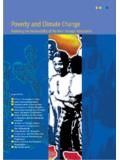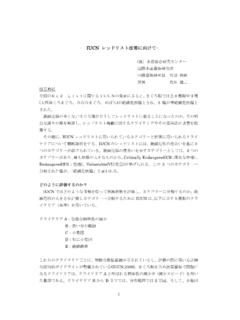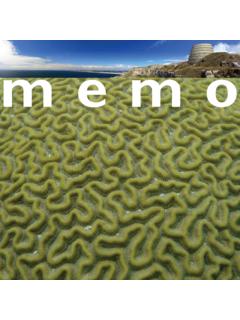Transcription of Vietnam Fisheries and Aquaculture Sector Study - World Bank
1 Vietnam Fisheries and Aquaculture Sector Study Final Report Ministry of Fisheries and The World Bank February 16, 2005 (2) ACKNOWLEDGEMENTS This Study was initiated following a request from Vietnam s Ministry of Fisheries (MOFi) to the World Bank Group. It was co-financed under the Japanese Global Trust Fund Programme for Sustainable Fisheries that was established with the World Bank to foster studies with governments to identify possible interventions in the Fisheries and Aquaculture Sector to improve management and to optimize the benefits through the sustainable use of aquatic resources for Fisheries production and Aquaculture development. That funding was aslso complemented with World Bank budget support. From MOFi, Minister Ta Quang Ngoc, Vice Minister Nguyen Viet Thang, Vu Van Trieu and Pham Trong Yen (International Cooperation Department) were particularly instrumental in initiating, conducting and providing guidance for the Study .
2 Mr. Hoang Viet Khang of the Ministry of Planning and Investment s External Economic Relationship Department also provided important direction for the Study with regard to national invetment priorities. There were also inputs provided from provinces visited in the north, central and southern regions of the country as well as other ministries, government agencies and donors based in Hanoi many of whom attended workshops in August and October 2004 in Hanoi to provide comment and feedback on the Study s findings. (See lists in Appendix M and Appendix L to this report.) The Study team was comprised of Ronald Zweig ( World Bank Team Leader), Ha Xuan Thong, Le Thanh Luu, Jon Cook, Michael Phillips, Nguyen Van Nguyen, and Nguyen Quang Huy (Consultants).
3 The Study and report also benefited significantly from comments from Macpherson (Bank); William Lane (Bank); Gert van Santen (consultant); and John Virdin (Bank) who were on the technical review panel for the Study . In addition from the World Bank, support for the Study was provided by Klaus Rohland (Country Director) and Martin Rama (Lead Economist) of the Vietnam Country Office and from Mark Wilson ( Sector ), Hoonae Kim ( Sector Manager), Stephen Mink, Laurent Msellati, Robin Mearns, Dzung The Nguyen, Binh Thang Cao, Thu Thi Le Nguyen, Minhnguyet Le Khorami and Dung Thi Thuy Dao of the East Asia and Pacific Rural Development and Natural Resources Sector Unit. (3) C O N T E N T S Page Executive Summary i I.
4 Fisheries Sector Trends and Current Status 1 A. Resources 1 B. Capture Fisheries 2 C. Aquaculture 5 D. Socio-Economic Aspects 6 E. Environment and Natural Resources 10 F. Development/Sustainable Management Opportunities and Constraints 11 II. Policies and Legal Framework 16 A. Fisheries Law, Policies and Decrees 16 B. International 18 C. Comanagement 19 D. Coastal Zone Planning and Management 19 E. Possible New Policy Directions 20 III. National and Local Institutions 21 A. Private Sector and SFEs 21 B. National and Provincial Institutions 22 C. Research and Education 24 D. Mass Organizations 27 E. Donor Programs, Projects and Cooperation 28 IV.
5 Public and Private Sector Cooperation and Stakeholders 29 A. Public Commercial and Service Activities 29 B. Joint Public and Private Sector Activities 30 C. Non-government Organizations 30 V. Support Services Constraints and Opportunities 31 A. Services to Capture Fisheries 31 B. Port Facilities 31 C. Aquaculture 32 D. Extension and Information 34 E. Fisheries Sector Credit 35 VI. Markets and Processing 36 A. Market Channels 36 B. Processing 37 C. Export Market Challenges 37 D. Future Demand and Price 39 E. Market Development Needs 39 VII. Development Priorities and Next Steps 39 A. Poverty and the Environment 40 B. Suggested Program Areas 41 C. Implementation, Coordination and Follow Up 46 (4) LIST OF TABLES Table 1 Biomass and estimated MSY 1 Table 2 Fishing gear usage 2 Table 3 Sources of fisher household income 2001 6 Table 4 State and non-state Fisheries enterprises 22 LIST OF FIGURES Figure 1 Mechanized fishing fleet 1991-2003 2 Figure 2 Proportion of fleet by engine size, 1992 and 2001 2 Figure 3 Marine capture fishery landings 1990-2002 3 Figure 4 Marine fish catch by region 1993-2003 3 Figure 5 Aquaculture area by region 5 Figure 6 Fishing labor 10 Figure 7 Volume and value of fishery product exports 36 Figure 8 Fish export prices 37 APPENDICES Appendix A: Decree 106 on Coastal Communes facing Special Difficulties Appendix B.
6 Fisheries Sector Statistics Appendix C: Persons and Institutions Consulted Appendix D: Fisheries Law and Policy Framework Appendix E: Marine Protected Areas Current Status Appendix F: Fisheries Sector and ICZM Projects Appendix G: Main Fishing Grounds Appendix H: Aquaculture Policies Appendix I: Aquaculture Trends, Sectoral Analysis and Environmental Issues Appendix J: Markets and Processing Appendix K: Development Priorities and Follow-up Recommendations Appendix L: Recommendations from MOFi Study Review Workshop -- August 31, 2004 Appendix M: Recommendations from the MOFi Workshop on 10-Year Investment Priorities -- October 28, 2004 ABBREVIATIONS ADB Asian Development Bank AIT Asian Institute of Technology BSP Bank for Social Policy CBD Convention on Biodiversity CIB Commercial and Industrial Bank CITES Commission on International Trade of Exotic Species DANIDA Danish International Development Agency DARD Provincial Department of Agriculture and Rural Development DFID United Kingdom Department for International Development DOFI Department of Fisheries (provincial) DOLISA Department of Labor, Invalids and Social Affairs (provincial) DONRE Department of Natural Resources and Environment (provincial) DOST Department of Science and Technology (provincial) (5)
7 DPI Department of Planning and Investment (provincial) EEZ Exclusive Economic Zone EIA Environment Impact Assessment EU European Union FA Farmers Association FAO Food and Agriculture Organization of the United Nations FICEN Fisheries Informatics Center FIIP Fisheries Infrastructure Improvement Project (ADB) FSPS Fisheries Sector Program Support (DANIDA/MOFi) GSO Government Statistics Office GEF Global Environment Facility FINIDA Finish International Development Agency hp horsepower of engine (= kW) ICZM integrated coastal zone planning and management IUCN International Conservation Union IFEP Institute of Fisheries Economics and Planning ITC International Trade Commission JICA Japan International Cooperation Agency MARD Ministry of Agriculture and Rural Development MOET Ministry of Education and Training MOFi Ministry of Fisheries MOLISA Ministry of Labor.
8 Invalids and Social Affairs MONRE Ministry of Natural Resources and Environment MOST Ministry of Science and Technology MPA marine protected area MPI Ministry of Planning and Investment MRC Mekong River Commission MSY Maximun Sustainable Yield NACA Network of Aquaculture Centers for Asia Pacific NAFIQAVED National Fisheries Quality Assurance and Veterinary Directorate NGO Non-government organization NOAA United Stated National Oceanic and Atmospheric Administration NORAD Norwegian Dvelopment Agency OIE Office International des Epizooties OSH Occupational Health and Safety PC Peoples Council PL post-larvae ( , of shrimp)
9 PPC Provincial People's Committee PDFRP Provincial Departments of Fishery Resources Protection PMU Project Management Unit PUA Port User Associations RIA Research Institute for Aquaculture RIMF Research Institute for Marine Fisheries SAPA Sustainable Aquaculture for poverty alleviation SEAFDEC Southeast Asia Fisheries Development and Economic Commission SFE State fishery enterprise SPS Sanitary and Phyto-sanitary TAC Total allowable catch UNEP United Nations Environment Programme VAC Integrated pond fish culture with agriculture and animal husbandry VASEP Vietnam Association of Seafood Exporters and Processors VBARD Vietnam Bank for Agriculture and Rural Development (6) VINAFIS Vietnam National Association of Fisheries VNICZM Vietnam Netherlands Integrated Coastal Zone Management project VSP Bank for Social Policy WU Women's Union WSSV White spot shrimp virus WTO World Trade Organization(i) EXECUTIVE SUMMARY 1.
10 Study Objectives 1. The Study has two main objectives: (i) to review the status and needs of the Fisheries , Aquaculture and aquatic resource management in Vietnam ; and (ii) to identify key areas of intervention that can reduce poverty, increase production and improve environmental management of the sectors on a sustainable basis. 2. Background and Status 2. The Fisheries and Aquaculture sectors are significant contributors to the economy of Vietnam . Direct production value (at the farm gate or on the wharf) in 2003 was approximately 25 trillion ($ billion) or approaching 4% of GDP. Available data show that the relative contribution from Aquaculture represented about 60% of the revenue generated while yielding under 40% of the total catch from capture Fisheries and Aquaculture .
















